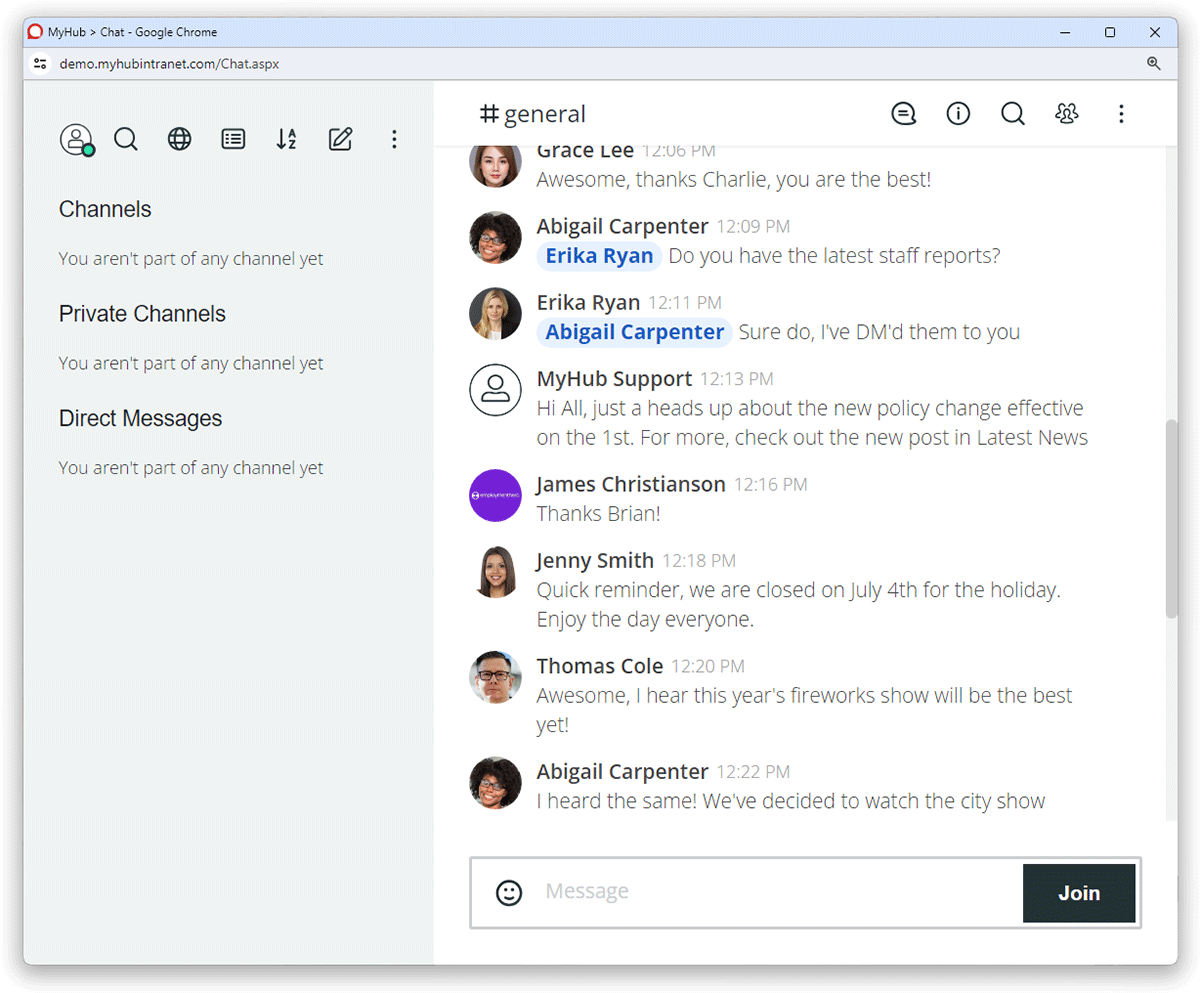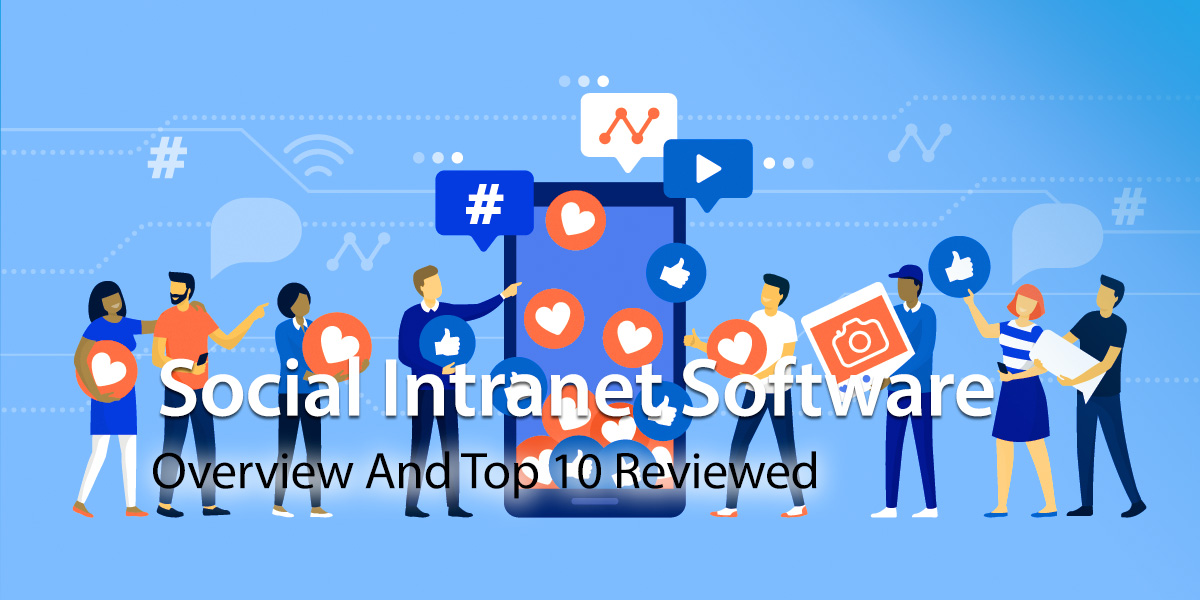More and more of us are using instant messaging to communicate in our personal lives. Over three billion users worldwide are signed up for Facebook Messenger, Skype, or WhatsApp, to name just a few. Not surprisingly, businesses also recognize the value of team chat software in the workplace. It could facilitate an online chat between remote workers or distributed teams. It might be as a platform for quickly resolving simple queries. Or it could open up two-way conversations with customers. Instant messaging can support communication and collaboration, revealing some surprising differences from the ole’ favorite email.
What Is Team Chat?
Team chat software is a communication tool that allows users to share messages and files or join channel discussions and group chats with others. Access is via a mobile device or a desktop.
Popular group chat apps include Microsoft Teams, Google Chat, and Slack.
All employees, whether remote, on-the-go, or office-based, can start a new conversation or create a discussion channel and collaborate with colleagues.
Team Chat Software Essential Features
Here’s a run-through of the essential features every business IM platform should have:
Real-time Chat
Users can start conversations and share emojis, files, and more in secure individual and group conversations.
Customization
You should be able to tailor the chat platform to your team’s needs. Enhance the user experience with customization features like notifications, themes, and integrations.
Searchable Chat History
You want easy access to past conversations and shared files. Searchable messages ensure teams can find relevant information super fast.
Team Chat App For Business Use
Businesses are increasingly using group chat to support internal communication. Unlike email, it’s much faster and more responsive. Users instantly receive notifications when they are online, and the sender can see straight away when the recipient has read the message. It’s immediate, so workers can be kept updated more efficiently than ever. Collaborative, meaningful online discussions resolve issues quickly, while vital information gets shared equally and inclusively.
Instant messaging also tends to be more accessible. Messages are usually brief and more like a casual chat. And perhaps because they are shorter and less formal, people typically reply immediately.
Chat Messages: Practical Business Uses
So, how are organizations using instant messaging in the workplace? Here are some practical examples of how you can apply it to your office.
Support Team Communication Regardless Of Location
A post-pandemic desire for a better work-life balance has seen more and more people embrace remote working. This trend is only likely to continue growing.
A team chat app provides a vehicle for these workers to communicate, connect, and share, bridging the divide of physical distance between users.
Instant messaging also allows remote or on-the-go workers to resolve issues quickly. Let’s say the finance manager has a query about an employee’s expense claim. Rather than a formal email, which the employee may not open until the next day, an instant message easily resolves the issue. The finance manager can process the claim immediately, and the employee receives their expenses the same day.
Help Teams Collaborate More Effectively
Real-time communication encourages active collaboration. All team members can join the conversation, contribute ideas, and offer feedback. Furthermore, it helps break down silos and improves transparency so there’s a shared understanding of goals and progress.
Increase Productivity
Chats can increase the speed with which the team shares information. Files and data are easily uploaded and shared instantly. Real-time communication means decisions are made quickly, resulting in more agile working and increased productivity.
Furthermore, group chat reduces the need for meetings and gets employees the answers they need without interrupting workflows.
Resolve Issues Quickly
A team chat app can be crucial in resolving issues and problems. After all, help from knowledgeable colleagues is just a ping away.
Say, for example, your HR manager wants to hold a team meeting to progress check on the new employee benefits package. However, finding a time and a day is time-consuming, especially as two team members work in different offices. So, instead of the bureaucracy involved in face-to-face meetings, video or conference calls, team members simply get together on the social intranet. An exchange of chat messages in a group discussion channel means the entire team is simultaneously updated.
Get Important Messages Out
Group chat via the social intranet is a great way to quickly get vital messages out there. Unlike email, where unread messages clog up employees’ inboxes worldwide, group chats are instant.
Perhaps your team member needs to make an urgent decision regarding a customer inquiry. The manager can respond immediately, possibly saving the deal.
Improve Customer Service
Furthermore, real-time team chat can support enhanced customer service. Businesses increasingly use bots to provide more responsive and personalized customer experiences, and instant messaging can help your frontline staff deliver better customer service.
For example, you may be on the phone talking to a potential customer who asks for specific details about a product they are interested in purchasing. You don’t know the information off the top of your head. However, a quick instant message to a colleague means you can answer the query without the customer being wiser.
Simply put, instant messaging offers the potential for streamlined internal communication and faster, more agile operations.
Introducing MyHub’s Team Chat
Here at MyHub, we have developed a team chat tool that is an integral part of our social intranet platform.
We have made it easier for an organization and its employees to start a new chat, send messages, organize conversations, and communicate across the organization. Team chat can support decision-making, agile company practices, and inter-office communication.
Among the great features on offer are the following:
Public or Private Chats
MyHub’s team chat means you can connect with and send messages to individuals or groups as you please. You can set up a channel discussion for company teams, such as marketing and finance. Or you could create chats that focus on a topic. It could be contributions to the end-of-year financials, the review of the marketing plan, or a Google Workspace user group.
Online Status of Colleagues
The team chat allows you to see who is online and available to chat. To start conversations, you only need to click a name. You can also see if someone is away, busy, or unavailable to chat.
And why not add a personal touch by including a profile picture? Users can identify with you as a person and put a face to the name.
Searchable Conversations
From time to time, you will need to go back to conversations to check relevant information. Every chat history is saved in the app, and searching your communications is straightforward. The search function works for all team chats, including channels, discussions, and private messages. Locating that all-important message is just a tap away.
File-sharing Capabilities
Share that vital document, image, or video privately and in a group conversation. Team chat makes it easy to upload files for instant sharing. And the good news is you can also search channels by file name.
Create Familiar #Channels
Most of us know and love #channels. We already follow them on our favorite social media platforms. Topical, team, or role-based channels are a fantastic way to alert workers to news and updates and keep them informed.
Moreover, you can use the @mentions feature to notify team members immediately of any new posts in their favorite channels.
Customizable Notifications
Need to knuckle down on a critical report? No problem, you can easily turn your team chat on and off or mute notifications with a tap of the keyboard. Decide when and how often you want to receive notifications by changing your preferences as appropriate. You can even receive an emailed summary at the end of the day.
Single Sign-on
Because the team chat is an integral part of the social intranet, only one sign-on is required. This means you won’t need to switch between multiple apps or screens, which will make you not only more organized but also more productive.
Simple To Set up
Using team chat is easy and intuitive. Check out the how-to video, follow the simple on-screen instructions, and set up your personalized chat system within the social intranet.
Benefits Of Team Chat
Instant messaging has much to offer when it comes to quick, easy, and responsive internal communications. Fully integrated with your existing social intranet, team chat provides accessible real-time communications. Even better, customer service and overall productivity will also receive a welcome boost.
Take a tour around team chat by signing up for a free demo. Or explore it for real in your business with a 14-day no-obligation trial.
Email vs. Instant Messaging
Businesses have been using email since the advent of the internet. Familiar, convenient, and easy to use, we all know and love email. And with over four billion users worldwide, it’s still the number one communication channel for many companies. From a business perspective, email is great for broadcasting group messages to large numbers of people. One email can reach thousands of staff. Furthermore, you can attach data and files and share them with all recipients.
Some argue that, unlike instant messaging, email is a better platform for longer or more complicated communications. Team chat works well for brief messages. Anything longer or requiring more explanation is probably better suited to email. Email is generally viewed as a more formal communication channel. That means potentially sensitive messages are better communicated through email – or, ideally, face-to-face.
Email is also easily accessible via a smartphone or device. Even non-desk staff or remote workers can pick up messages. However, it’s impossible to see if the recipient has opened, let alone read the message.
The Dreaded Long Threaded Email
Another disadvantage of email compared to chat messages is that it has limited value when it comes to group discussions. Forwarded emails with long and complicated threads can quickly become impossible to follow and overly complicated. By contrast, instant messaging is a more natural and easy-to-follow form of communication better suited to group discussions.
Most importantly, emails are not real-time communication. There is always a time lag involved. If you need a decision quickly, email may not be your first choice, even more so if the decision requires several people. But there is no doubt that email still has a place in the modern office: worldwide, we sent nearly 350 billion business emails last year alone!
In summary, email still has a role, but it’s a lesser one. If your organization is looking to complement email and is interested in finding out how MyHub’s all-in-one integrated solution for instant messaging can help, book a short free demo. You can also give it a try with a 14-day no-obligation trial.










